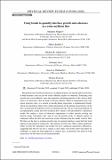Using braids to quantify interface growth and coherence in a rotor-oscillator flow
Author(s)
Filippi, Margaux; Budišić, Marko; Allshouse, Michael R.; Atis, Séverine; Peacock, Thomas
DownloadPublished version (2.856Mb)
Publisher Policy
Publisher Policy
Article is made available in accordance with the publisher's policy and may be subject to US copyright law. Please refer to the publisher's site for terms of use.
Terms of use
Metadata
Show full item recordAbstract
The growth rate of material interfaces is an important proxy for mixing and reaction rates in fluid dynamics and can also be used to identify regions of coherence. Estimating such growth rates can be difficult, since they depend on detailed properties of the velocity field, such as its derivatives, that are hard to measure directly. When an experiment gives only sparse trajectory data, it is natural to encode planar trajectories as mathematical braids, which are topological objects that contain information on the mixing characteristics of the flow, in particular through their action on topological loops. We test such braid methods on an experimental system, the rotor-oscillator flow, which is well described by a theoretical model. We conduct a series of laboratory experiments to collect particle tracking and particle image velocimetry data, and we use the particle tracks to identify regions of coherence within the flow that match the results obtained from the model velocity field. We then use the data to estimate growth rates of material interface, using both the braid approach and numerical simulations. The interface growth rates follow similar qualitative trends in both the experiment and model, but have significant quantitative differences, suggesting that the two are not as similar as first seems. Our results shows that there are challenges in using the braid approach to analyze data, in particular the need for long trajectories, but that these are not insurmountable.
Date issued
2020-05Department
Massachusetts Institute of Technology. Department of Mechanical Engineering; Woods Hole Oceanographic InstitutionJournal
Physical Review Fluids
Publisher
American Physical Society (APS)
Citation
Filippi, Margaux et al. "Using braids to quantify interface growth and coherence in a rotor-oscillator flow." Physical Review Fluids 5, 5 (May 2020): 054504 © 2020 American Physical Society
Version: Final published version
ISSN
2469-990X